 Expert's opinion
Expert's opinion
Expert's opinion
The article is a subjective view on this topic written by writers specializing in medical writing.
It may reflect on a personal journey surrounding struggles with an illness or medical condition, involve product comparisons, diet considerations, or other health-related opinions.
Although the view is entirely that of the writer, it is based on academic experiences and scientific research they have conducted; it is fact-checked by a team of degreed medical experts, and validated by sources attached to the article.
The numbers in parenthesis (1,2,3) will take you to clickable links to related scientific papers.
10 Standing Exercises For Belly Fat To Shape Your Stomach In 2024
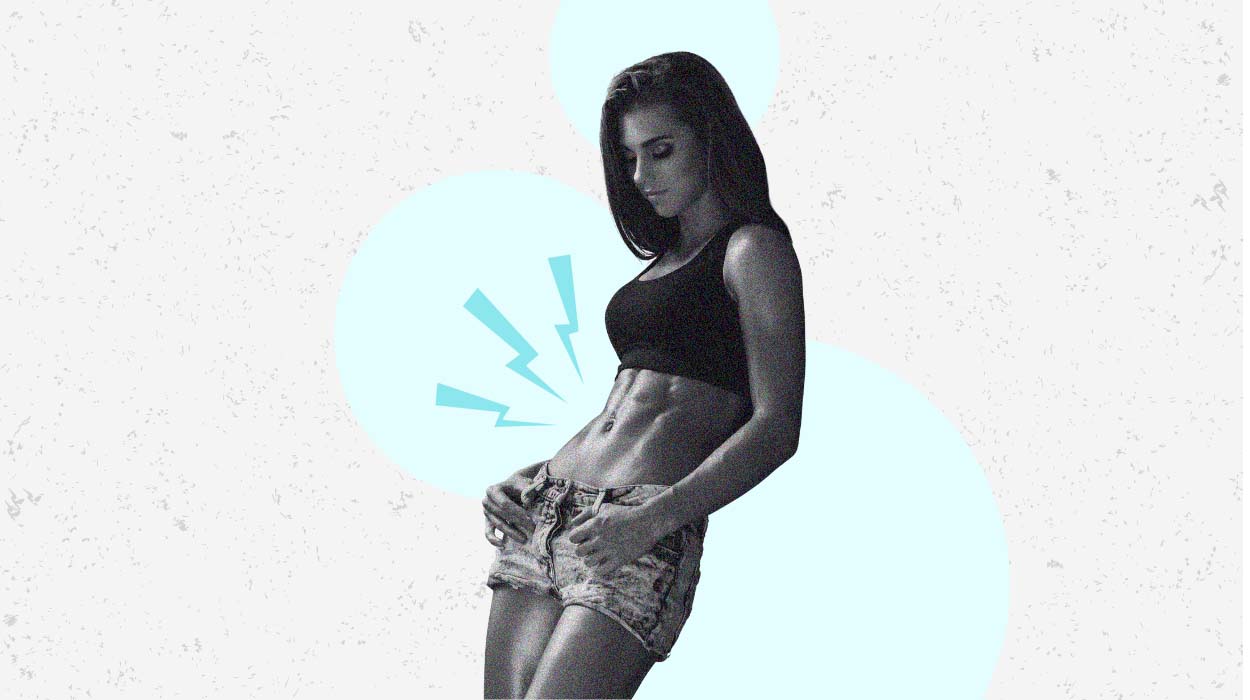
Feeling comfortable with your belly can be difficult if you struggle with flabby abs, stubborn belly fat, or weight management. There are healthy ways to shape your tummy, lose belly fat, and feel and look your best.
Making dietary choices that support safe weight loss, creating a flat belly, and executing specific exercises will get you the desired results you seek. Learn more about standing abs exercises to reduce belly fat which promotes an attractive stomach, strengthens core muscles, and helps with controlling your weight.
10 Standing Exercises To Lose Belly Fat You Can Do Daily
You don’t have to get on the floor to exercise your abs and eradicate belly fat. Engage in standing exercises like Windmills, Jumping Oblique Twists, or Standing Cross Crunches to blast away a beer gut. The abdomen tends to hold onto fat more than other parts of the body. But, regularly practicing standing ab exercises, eating a balanced diet, and choosing healthy lifestyle choices can help you achieve a toned, flattering tummy and waistline.
We will cover ten different easy standing exercises that will help your body lose belly fat, tone ab muscles, and create a leaner, fitter you.
10 Best Standing Exercises For Belly Fat
Let’s explore each standing abs workout, the muscle groups it targets, and the overall health benefits provided.
Jumping Oblique Twist
The primary muscles targeted by this exercise are the lower abs and left and right obliques. The lower back muscles are also targeted, and this exercise is considered a cardio move.
How to do:
- Stand with your feet shoulder-width apart, keeping your knees slightly bent and your back straight.
- Place your hands behind your head, with your elbows pointing out to the sides.
- Engage your core muscles to stabilize your torso.
- Jump up explosively, twisting your torso to the left and bringing your right knee up towards your left elbow as you rotate.
- As you land, immediately jump again, this time twisting your torso to the right and bringing your left knee up towards your right elbow as you rotate.
- Continue alternating sides with each jump, maintaining a brisk and controlled pace.
- Aim to perform the exercise for a specific duration or a set number of repetitions.
Tips:
- Land softly with each jump to minimize the impact on your joints, and focus on the quality of the twist rather than speed.
- Keep your chest lifted and your back straight to maintain proper posture throughout the exercise, avoiding excessive leaning forward or backward.
- To intensify the workout, you can hold a light weight or medicine ball while performing.
Optimal Sets and Reps: two to three sets of 12-15 reps.
Standing Oblique Crunches
Executing this exercise works your muscles to improve balance, stability, strength, and burn calories. It targets the oblique muscles and side ab wall better than doing side crunches on the floor. Consider slight alternatives to this exercise to boost the impact of building ripped abs and core strength.
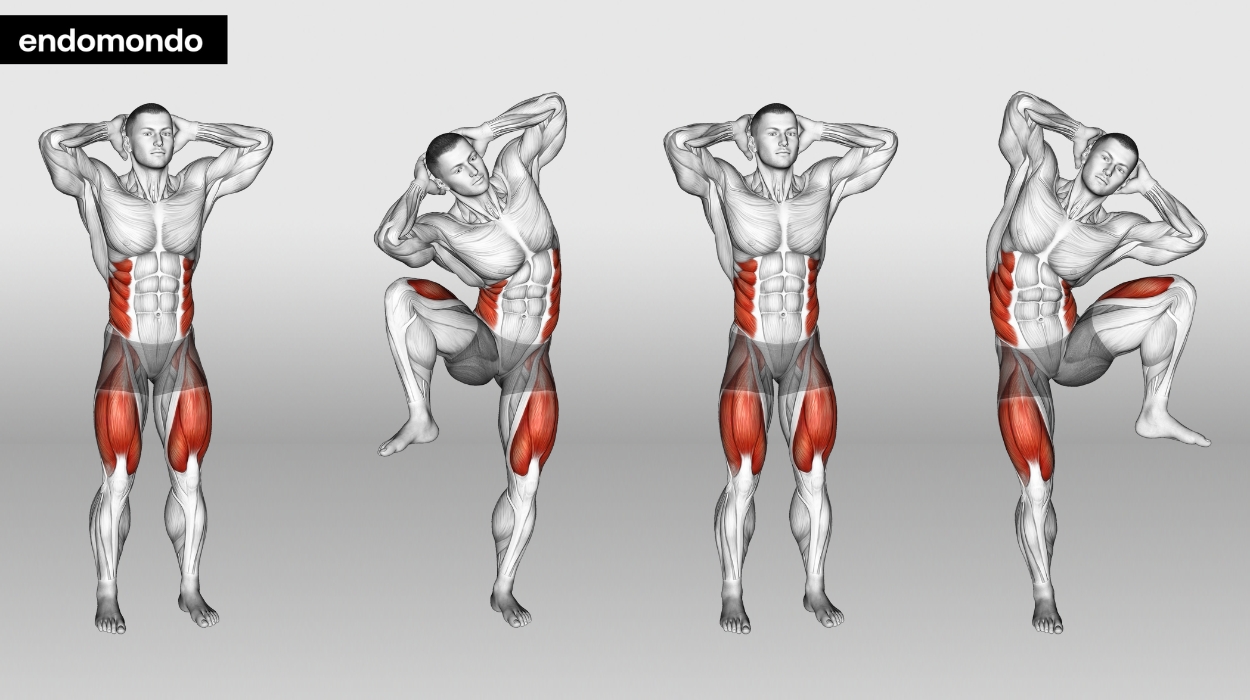
How to do:
- Stand up straight with your feet hip-width apart.
- Place your hands behind your head, interlocking your fingers or lightly touching your head to support your neck.
- Engage your core muscles by pulling your belly button in towards your spine to stabilize your midsection.
- Shift your weight onto your right foot while slightly lifting your left foot off the ground. This will be your starting position.
- While balancing on your right foot, bend your torso to the left side, bringing your left knee and your left elbow closer together in a crunching motion.
- Squeeze your oblique muscles on the left side as you perform the crunch.
- Slowly return to the starting position with control.
- Repeat the movement for the desired number of repetitions on the left side before switching to the right side.
- Aim to perform the exercise for a specific duration or a set number of repetitions on each side.
Tips:
- Ensure your movements are controlled and focus on squeezing your oblique muscles at the peak of each crunch to maximize muscle engagement.
- Keep your chest open and your shoulders relaxed to maintain proper posture and prevent strain in the upper body.
- To add variety to your oblique workout, you can perform with different hand positions, such as placing your hands on your hips or reaching them straight overhead.
Optimal Sets and Reps: two to three sets of 12-15 reps.
Standing Cross Crunches
You can execute this exercise, including variations where you crisscross or go cross-body. Not only does this move help target the obliques and abs, but the lower body gets a workout, too, improving the hamstring and quadriceps.
How to do:
- Stand up straight with your feet hip-width apart.
- Place your hands behind your head, interlocking your fingers or lightly touching your head to support your neck.
- Engage your core muscles by pulling your belly button in towards your spine to stabilize your midsection.
- Begin with your hands and elbows pointing out to the sides.
- Lift your right knee towards your left elbow, bringing them together in a cross crunching motion.
- Squeeze your oblique muscles on the left side as you perform the crunch.
- Return your right foot to the ground and your right elbow to its original position.
- Repeat the movement for the desired number of repetitions on the right side.
- Switch to the left side, lifting your left knee towards your right elbow while performing the cross crunch.
- Aim to perform the exercise for a specific duration or a set number of repetitions on each side.
Tips:
- Exhale as you crunch, bringing your elbow and knee together, and inhale as you return to the starting position to maintain a steady breathing rhythm.
- Focus on the quality of the movement rather than speed, ensuring you’re fully engaging your oblique muscles with each repetition.
- To intensify the workout, you can add resistance by holding a light dumbbell or medicine ball.
Optimal Sets and Reps: two to three sets of 12-15 reps.
Static Lunge Ab Twist
Increase the benefits of performing this standing ab exercise by adding weights or a medicine ball. Get the best out of this move that targets the lower and upper body, working core muscles, glutes, hamstrings, and quads. Feel the burn, slay belly fat, tone abs, and improve balance.
How to do:
- Start by standing up straight with your feet hip-width apart.
- Take a step forward with your right foot, creating a wide stance.
- Lower your body into a static lunge position by bending both knees. Ensure that your right knee is directly above your right ankle, and your left knee hovers slightly above the ground.
- Keep your back straight, chest up, and engage your core for stability.
- Extend your arms straight out in front of you, palms together.
- While maintaining the lunge position, twist your torso to the right side as far as you comfortably can, keeping your arms extended and parallel to the ground.
- Return to the center and twist your torso to the left side, again keeping your arms extended and parallel to the ground.
- Continue alternating twists from right to left, all while holding the lunge position.
- Complete the desired number of repetitions on the right side before switching to the left side.
Tips:
- Keep your back straight and your chest lifted throughout the exercise to maintain good posture and reduce the risk of strain in your lower back.
- Focus on controlled movements, twisting your torso with control and not using momentum to complete the twist.
- To challenge yourself further, you can hold a light dumbbell or medicine ball at chest height while performing.
Optimal Sets and Reps: two to three sets of 12-15 reps.
High Knee Run
It is essential to perform cardio exercises to boost metabolism, burn calories, and improve strength and endurance. Executing this exercise strengthens the abs, enhances flexibility, momentum, coordination, and gets your heart rate going. Perform this move regularly to work out your abs, work your hips, activate your core muscles, and strengthen your legs in one fail swoop.
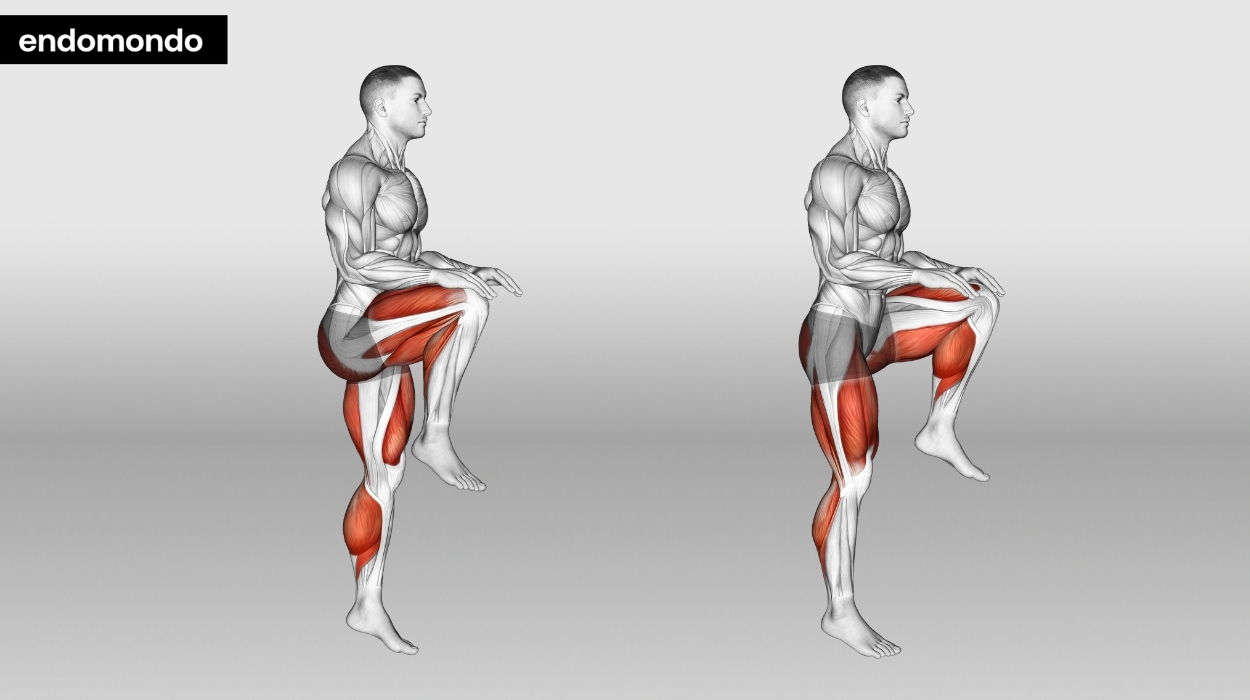
How to do:
- Stand up straight with your feet hip-width apart.
- Begin by jogging in place at a moderate pace to warm up your muscles.
- As you get comfortable with the jogging motion, start lifting your knees higher with each step.
- Gradually increase the pace and intensity, driving your knees upward toward your chest.
- Swing your arms in coordination with your legs to mimic a running motion.
- Aim to lift your knees as high as possible with each step while maintaining a brisk pace.
- Continue this high knee running motion for a specific duration or as part of a cardio workout routine.
Tips:
- Land softly on the balls of your feet with each step to reduce the impact on your joints and maintain a smooth rhythm.
- Keep your back straight and maintain an upright posture throughout the exercise to avoid leaning forward or backward.
- As you progress, you can increase the intensity by adding intervals of high knee running into your cardio routine, aiming for 3-5 sets with short breaks in between for a more challenging workout.
Optimal Sets and Reps: two to three sets of 30-60 seconds.
Standing Core Stabilizer
Target belly fat and build core muscles to reduce back pain and support the spine with this move. Promote abdominal strength, increase stability, improve breathing, coordination, and reduce your waistline. Regularly practicing standing core exercises is essential to sculpting your midsection and reducing belly fat.
How to do:
- Stand up straight with your feet hip-width apart and hold a weight or a medicine ball close to your chest with both hands.
- Engage your core muscles by pulling your belly button in towards your spine to stabilize your midsection.
- Lift the weight or medicine ball straight up and away from your chest, extending your arms fully while keeping them close to your body.
- Hold the weight in the extended position for a moment, maintaining your balance and stability.
- Slowly lower the weight back to your chest, maintaining control throughout the movement.
- Repeat the exercise for the desired number of repetitions.
Tips:
- Breathe steadily throughout the exercise, inhaling as you lift your knee and exhaling as you lower it to maintain a consistent rhythm.
- Focus on keeping your standing leg slightly bent and your foot firmly planted to enhance stability.
- To challenge your balance further, you can close your eyes or stand on a balance cushion while performing.
Optimal Sets and Reps: two to three sets of 12-15 reps.
Cross Chops
Workout ab muscles build strength and stability in your hip and trunk when doing rotations. Practice cross chops and alternate versions to work the transverse abdominal muscles, obliques, back, legs, and shoulders.
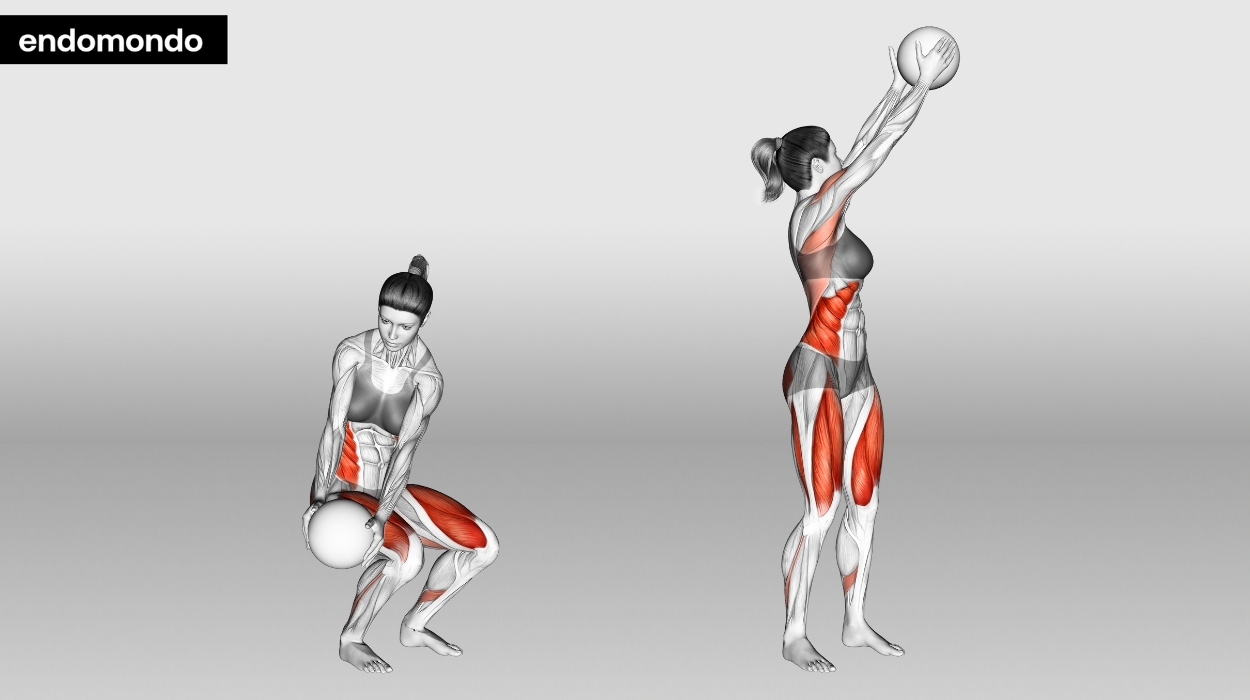
How to do:
- Stand up straight with your feet shoulder-width apart.
- Hold a dumbbell or a medicine ball with both hands at chest level, close to your body.
- Engage your core muscles by pulling your belly button toward your spine to stabilize your midsection.
- Begin by twisting your torso to the right side while keeping your lower body stable.
- As you twist, pivot on your right foot and lift the dumbbell or medicine ball diagonally across your body, aiming to bring it towards your left hip.
- Imagine that you are chopping wood diagonally across your body as you perform this motion.
- Keep your arms extended but slightly bent at the elbows throughout the movement.
- Return to the starting position by untwisting your torso and lowering the weight back to chest level.
- Now, repeat the movement in the opposite direction. Twist your torso to the left side while pivoting on your left foot and lifting the weight diagonally across your body toward your right hip.
Tips:
- Keep your arms extended throughout the movement, maintaining a slight bend in your elbows to avoid locking them.
- Focus on a controlled and deliberate motion, avoiding any jerky or rushed movements to ensure proper form.
- Feel free to add dumbbells if doing a cross-body chop or other variants while working on balance and strengthening the core.
Optimal Sets and Reps: two to three sets of 10-12 reps.
Warrior Balance
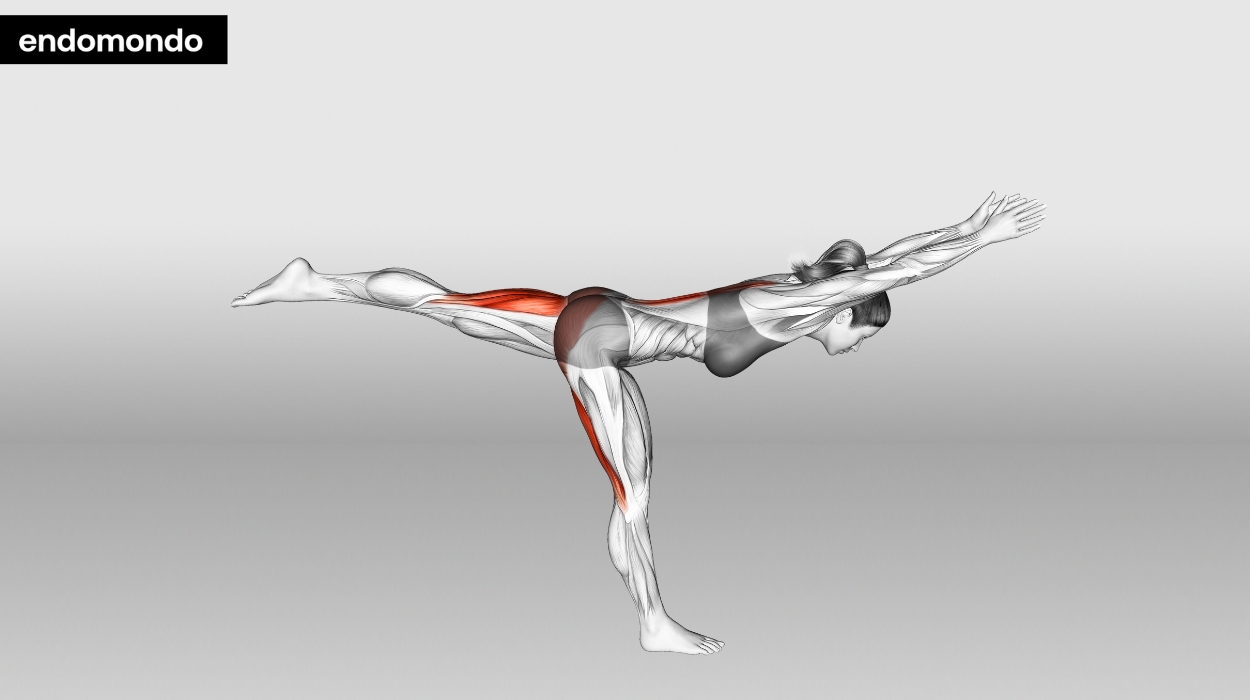
Engage all of the muscles in your core, legs, and arms while strengthening the back. Using this move helps improve spinal alignment, balance, and enhances stability and power. Encourage better endurance, breathing, strength, and focus with this yoga move.
How to do:
- Start by standing at the front of your mat with your feet together and your arms by your sides.
- Shift your weight onto your right foot and engage your core muscles.
- Begin to lift your left leg behind you while simultaneously leaning your upper body forward. Your left leg, torso, and arms should form a straight line, parallel to the floor.
- Extend your arms forward in line with your torso, with your palms facing down. Your fingertips should be pointing forward.
- Keep your hips squared and your left foot flexed, creating a straight line from your head to your left heel.
- Find a focal point to help with balance and maintain a steady gaze on that spot.
- Breathe deeply and hold the pose for a specific duration, such as 30 seconds to 1 minute, or as long as you can maintain proper form and balance.
- To come out of the pose, gently lower your left leg to the floor and return to a standing position with both feet together.
- Repeat the exercise on the other side by shifting your weight onto your left foot and lifting your right leg behind you.
Tips:
- Keep your hips squared forward and your pelvis level as you extend your back leg, avoiding any tilting or twisting of the hips.
- Maintain a slight bend in your supporting knee to prevent it from locking, which can help with stability.
- For an added challenge, try closing your eyes while performing the Warrior Balance exercise to further improve your balance and proprioception.
Optimal Sets and Reps: two to three sets of 8-10 reps.
Windmill

Give this exercise move a boost by adding a kettlebell or dumbbell. Get ready to burn off calories, and improve stability and strength in the core, obliques, glutes, and shoulders. The hamstrings and hips benefit from improved flexibility.
How to do:
- Stand with your feet shoulder-width apart and your toes pointing slightly outward. Keep your knees slightly bent throughout the exercise.
- Extend your arms straight out to the sides, forming a “T” shape with your body.
- Engage your core muscles by pulling your belly button toward your spine to stabilize your midsection.
- Begin by slowly tilting your upper body to the right side while keeping your arms extended and your left hand pointing down towards your right foot.
- Keep your back straight and chest open as you tilt to the side. You should feel a stretch along your left side.
- As you tilt to the right, simultaneously slide your right hand down your right leg, reaching toward your right ankle or shin. Your left hand should still be pointing down.
- Continue to hinge at your waist, trying to bring your chest parallel to the ground or as close as you can comfortably reach.
- Hold this stretched position for a moment, feeling the stretch along your left side and maintaining balance.
- Slowly reverse the movement by returning to the upright position, lifting your torso, and bringing your arms back to the “T” position.
- Repeat the same sequence on the left side, tilting your upper body to the left and reaching down with your left hand toward your left ankle or shin.
Tips:
- Keep your eyes on the weight or your hand as you lower it to maintain proper alignment and balance.
- Focus on maintaining a straight line from your extended hand down to your grounded foot to maximize the stretch and engagement of your obliques.
- Another good variation of this exercise is the hybrid kneeling windmill.
Optimal Sets and Reps: two to three sets of 8-10 reps.
Wood Chop
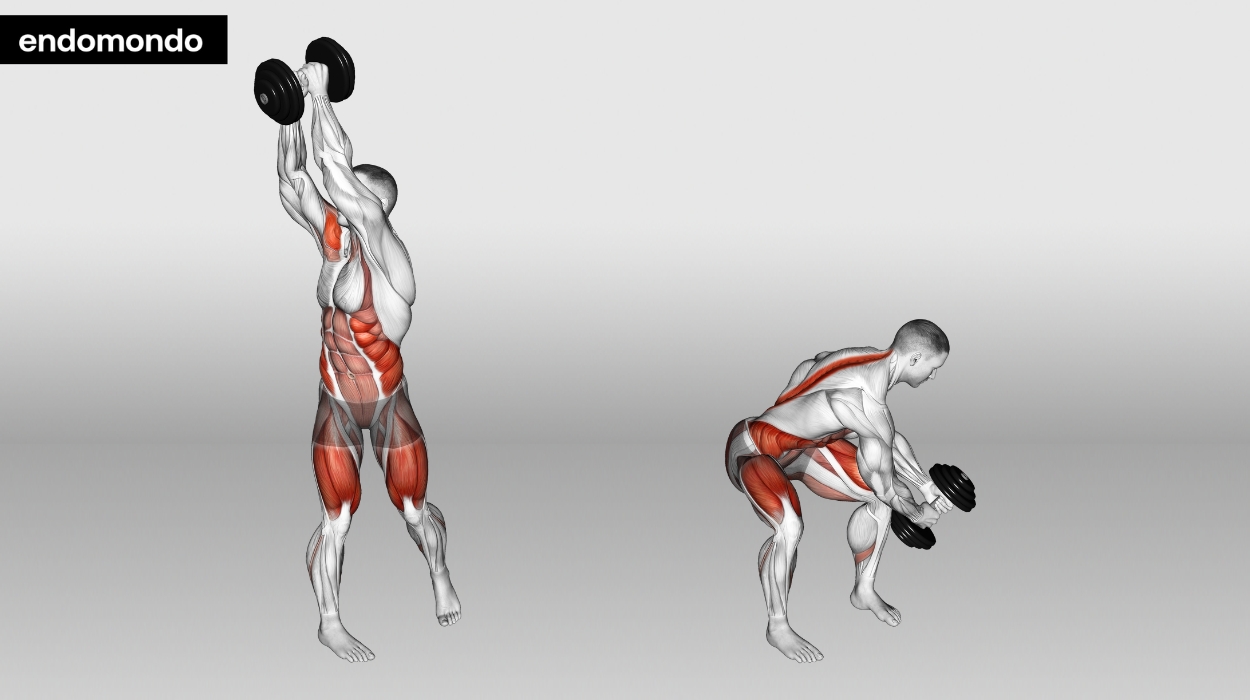
Performing this exercise will contribute to getting ripped, washboard abs. The chopping wood moves and variations target the abs, lower and upper back, arms, chest, legs, and glutes. Also, executing this move often helps build strength and stability in the hip and shoulder.
How to do:
- Stand with feet shoulder-width apart, holding a dumbbell or attaching a resistance band at chest height.
- Engage your core muscles by pulling your belly button in.
- Start with the weight at chest height close to your right shoulder.
- Rotate your torso diagonally, pivot on your left foot, and lower the weight towards your left hip or knee.
- Keep your arms straight and core engaged throughout.
- Reverse the movement, rotating back to the starting position.
- Exhale as you chop down, inhale as you return up.
Tips:
- Keep your arms extended throughout the movement, maintaining a slight bend in your elbows to avoid locking them.
- Focus on a controlled and deliberate motion, avoiding any jerky or rushed movements to ensure proper form and minimize the risk of injury.
- Feel free to make things more challenging by adding a resistance cable or practicing standing ab exercises with weights.
Optimal Sets and Reps: two to three sets of 10-12 reps.
What Causes Stubborn Belly Fat?
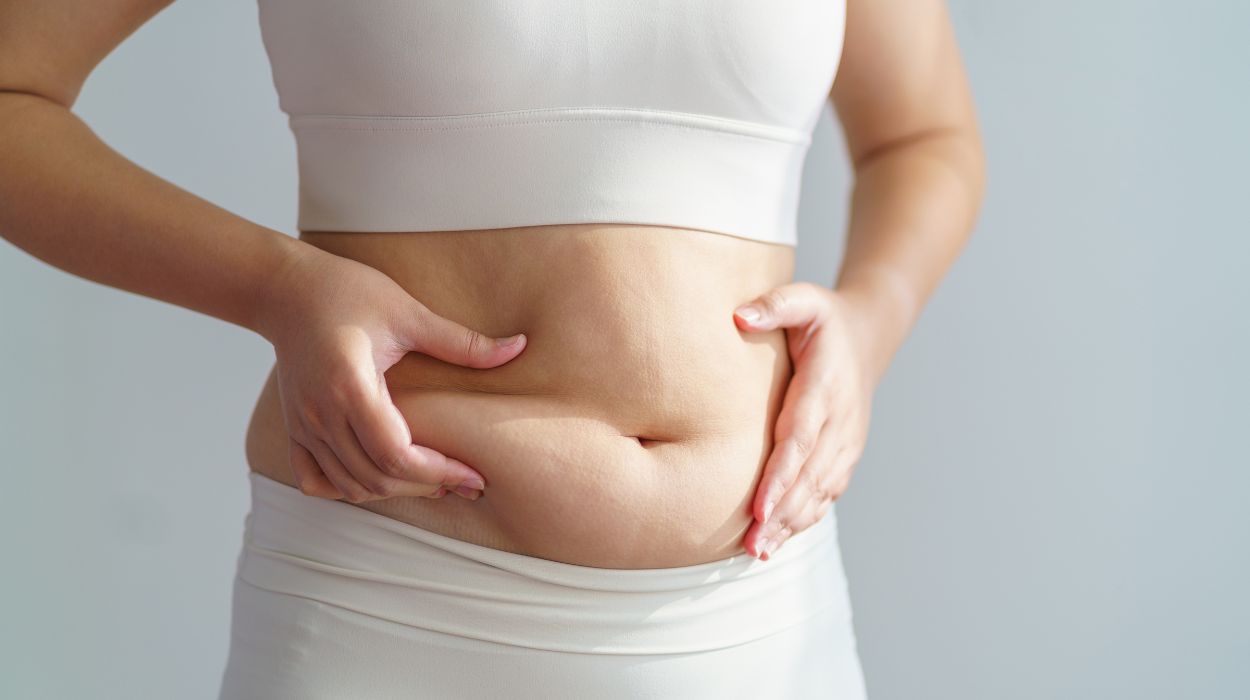
The struggle to maintain a healthy weight and reduce lower belly fat impacts both men and women.
However, there are some critical reasons why it may be hard for the body to lose belly fat around the waistline.
Depending on which factors prove to be the most significant in your life, you can better determine a plan to eradicate belly fat successfully. Having a pesky problem like belly fat may be impacted by the following factors:
- Genetics[1]
- Diet
- Stress
- Medications
- Age
Learning what triggers the development of fat around the waistline and lower belly is critical to figuring out the best solution to get rid of a beer gut. There is no one-size-fits-all solution as every individual has different needs.
How And Why Does Lower Belly Fat Form?
Excessive belly fat or a beer gut can occur because of binge drinking, a poor diet, a sedentary lifestyle, stress, genetics, poor sleep, or smoking. Additionally, enzymes, an imbalanced gut microbiota[2], consuming too many fats, or an excess intake of calories can also contribute to stubborn lower belly fat. For women, belly fat may be more common and hard to lose following menopause.
Unfortunately, the human body tends to want to hold onto fat around the waistline and belly because of evolution. Fat helps to insulate organs and provide energy if there is a lack of access to food and nutrition for an extended time. Regularly exercising and eating a healthy diet can help offset genetics, hormonal response, and other contributing factors to stubborn lower belly fat.
How Does Lower Belly Fat Impact Health?
It is crucial to reduce excess fat around the abdomen and waistline. It can contribute to various metabolic syndromes[3] diseases and disturbances. Persons with belly fat that is hard to lose may have an increased risk for type 2 diabetes, cardiovascular disease, stroke, cancer, and other ailments. Women, in particular, may have more health risks[4] and dangers because of their lower belly fat than men.
Why Is It Important To Target The Abs?
Developing and maintaining strong core muscles and shapely abs goes beyond satisfying one’s physical appearance. Holding onto excess fat around the belly and waistline can trigger and exacerbate health ailments over time. Regularly practicing exercises that strengthen core muscles and tone abs helps improve posture, strength, balance, weight management, and waistline.
How Long Until You See Noticeable Results?
In as little as two weeks, you can see noticeable results of performing standing exercises for lower belly fat that tone and shape your abs. After this short time, posture improves, and you’ll see changes in your muscle tone. After three to four months, the muscles may show further growth and development.
Other Ways To Reduce Belly Fat And Shape Abs
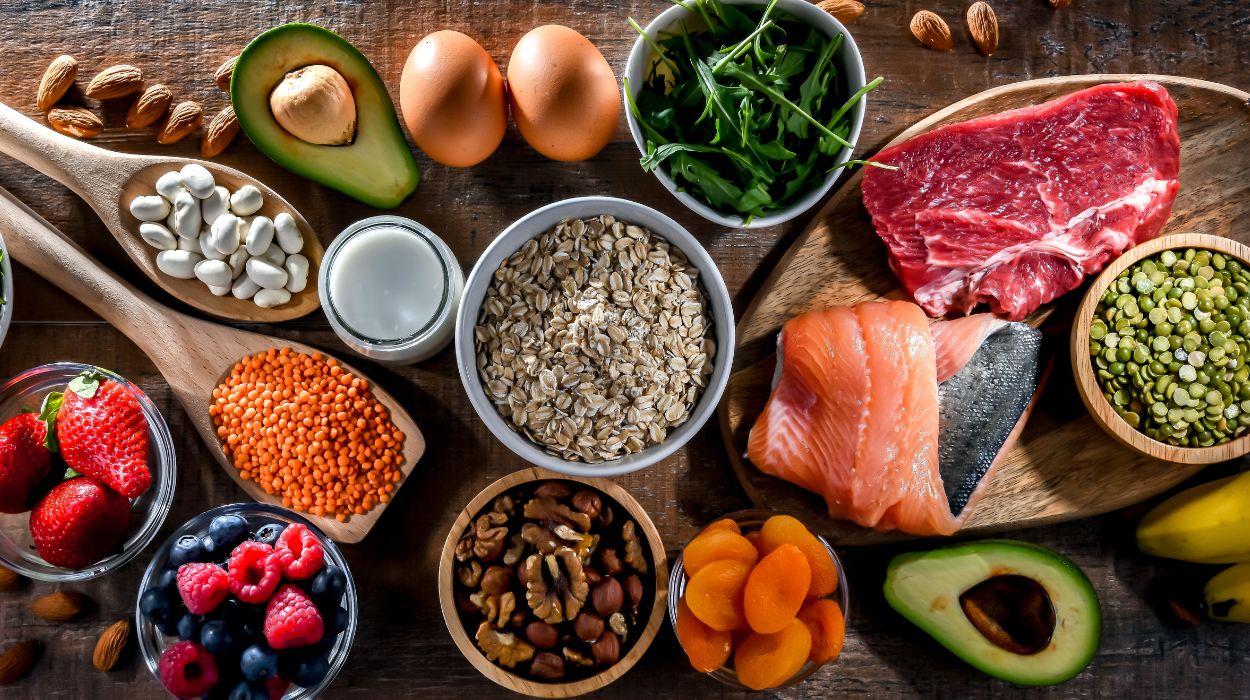
The following can be beneficial when building a flatter belly, reducing a beer gut, and developing solid and shapely abs.
- Make healthy dietary changes.
- Reduce stress.
- Follow healthy lifestyle changes.
- Practice regular cardio exercise and weight resistance.
When you want to burn fat and lose weight, there are other things you can use alongside executing specific standing exercises for lower belly fat.
Precautions
Before beginning any new exercise regimen or making dietary changes consult your physician. It is normal for your body to display physical reactions to a change in your routine. One may notice fatigue, sore muscles, increased energy, improved metabolism, weight loss, and a reduced waistline. Ease into exercises, be patient, and use good form to reduce possible injury.
Exercise caution when adding supplements to your diet, making significant lifestyle changes, or working out more frequently. People with certain pre-existing health conditions, taking prescribed medications, or are postnatal or pregnant may see varied results from standing exercises for lower belly fat.
+ 4 sources
Health Canal avoids using tertiary references. We have strict sourcing guidelines and rely on peer-reviewed studies, academic researches from medical associations and institutions. To ensure the accuracy of articles in Health Canal, you can read more about the editorial process here
- Hélène Choquet and Meyre, D. (2011). Genetics of Obesity: What have we Learned? [online] 12(3), pp.169–179. doi:https://doi.org/10.2174/138920211795677895.
- Ludovico Abenavoli, Emidio Scarpellini, Colica, C., Boccuto, L., Salehi, B., Javad Sharifi-Rad, Aiello, V., Romano, B., A De Lorenzo, Izzo, A.A. and Capasso, R. (2019). Gut Microbiota and Obesity: A Role for Probiotics. [online] 11(11), pp.2690–2690. doi:https://doi.org/10.3390/nu11112690.
- Galassi, A., Reynolds, K. and He, J. (2006). Metabolic Syndrome and Risk of Cardiovascular Disease: A Meta-Analysis. [online] 119(10), pp.812–819. doi:https://doi.org/10.1016/j.amjmed.2006.02.031.
- Janssen, I., Katzmarzyk, P.T. and Ross, R. (2002). Body Mass Index, Waist Circumference, and Health Risk. [online] 162(18), pp.2074–2074. doi:https://doi.org/10.1001/archinte.162.18.2074.



